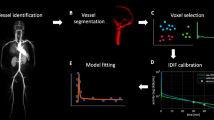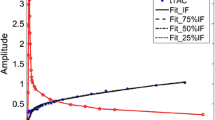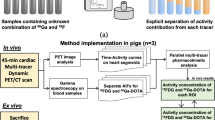Abstract
To date no satisfactory method has been available for the quantitative in vivo measurement of the complex hepatic blood flow. In this study two modelling approaches are proposed for the analysis of liver blood flow using positron emission tomography (PET). Five experiments were performed on three foxhounds. The anaesthetised dogs were each given an intravenous bolus injection of oxygen-15 labelled water, and their livers were then scanned using PET. Radioactivity in the blood from the aorta and portal vein was measured directly and simultaneously using closed external circuits. Time-activity curves were constructed from sequential PET data. Data analysis was performed by assuming that water behaves as a freely diffusible tracer and adapting the standard one-compartment blood flow model to describe the dual blood supply of the liver. Two particular modelling approaches were investigated: the dual-input model used both directly measured input functions (i.e. using the hepatic artery and the portal vein input, determined from the radioactivity detected in the aorta and portal vein respectively) whereas the single-input model used only the measured arterial curve and predicted the corresponding portal input function. Hepatic arterial flow, portal flow and blood volume were fitted from the PET data in several regions of the liver. The resulting estimates were then compared with reference blood flow measurements, obtained using a standard microsphere technique. The microspheres were injected in a separate experiment on the same dogs immediately prior to PET scanning. Whilst neither the single- nor the dual-input models accurately reproduced the arterial reference flow values, the flow values from the single-input model were closer to the microsphere flow values. The proposed single-input model would be a good approximation for liver blood flow measurements in man. The observed discrepancies between the PET and microsphere flow values may be due to the inherent temporal and spatial heterogeneity of liver blood flow. The results presented suggest that adaptation of the standard one-compartment blood flow model to describe the dual blood supply of the liver is limited and other flow tracers have to be considered for quantitative PET measurements in the liver.
Similar content being viewed by others
References
Johnson DJ, Muhlbacher F, Wilmore DW. Measurement of hepatic blood flow.J Surg Res 1985; 39: 470–481.
Taniguchi H, Daidoh T, Shioki Y, Takahashi T. Blood supply and drug delivery to primary and secondary human liver cancers studied with in vivo bromodeoxyuridine labeling.Cancer 1993; 71: 50–55.
Greenway CV. In: Lautt WW, ed.Hepatic plethysmography in hepatic circulation in health and disease. New York: Raven Press; 1981: 41–54.
Kolin A. An electromagnetic flow meter. Principles of the method and its application to blood flow measurements.Proc Soc Exp Biol Med 1936; 35: 53–56.
Anderson MF. Pulsed Doppler ultrasonic flowmeter: application to the study of hepatic blood flow. In: Granger DN, Bulkley GB, eds.Measurement of blood flow: applications to the splanchnic circulation. Baltimore: Williams & Wilkins; 1981: 395–398.
Gibbs FAA. A thermoelectric bloodflow recorder in form of a needle.Proc Soc Exp Biol Med 1933; 31: 141–146.
Schmitz-Feuerhake I, Huchzermeyer H, Reblin T. Determination of the specific blood flow of the liver by inhalation of radioactive rare gases.Acta Hepatogastroenterol 1975; 22: 150–158.
Sherriff SB, Smart RC, Taylor I. Clinical study of liver blood flow in man measured by133Xe clearance after portal vein injection.Gut 1977; 18: 1027–1031.
Lam PH, Mathie RT, Harper AM, Blumgart LH. A simple technique of measuring blood flow — intrasplenic injection of133xenon.Acta Chir Scand 1979; 145: 95–100.
Biersack HJ, Torres J, Thelen M, Monzon O, Winkler C. Determination of liver and spleen perfusion by quantitative sequential scintigraphy in normal subjects and in patients with portal hypertension.Clin Nucl Med 1981; 6: 218–220.
Fleming JS, Ackery DM, Walmsley BH, Karran SJ. Scintigraphic estimation of arterial and portal blod supplies to the liver.J Nucl Med 1983; 24: 1108–1113.
Frackowiak RSJ, Lenzi GL, Jones T, Heather JD. Quantitative measurement of regional cerebral blood flow and oxygen metabolism in man using15O and positron emission tomography: theory, procedure and normal values.J Comput Assist Tomogr 1980; 4: 727–736.
Herscovitch P, Markham J, Raichle ME. Brain blood flow measured with intravenous H2 15O. I. Theory and error analysis.J Nucl Med 1983; 24: 782–789.
Raichle ME, Martin WRW, Herscovitch P, Mintun MA, Markham J. Brain blood flow measured with intravenous H2 15O. II. Implementation and validation.J Nucl Med 1983; 24: 790–798.
Lammertsma AA, Cunningham VJ, Deiber MP, Heather JD, Bloomfield PM, Nutt J, Frackowiak RSJ, Jones T. Combination of dynamic and integral methods for generating reproducible functional CBF images.J Cereb Blood Flow Metab 1990; 10: 675–686.
Bergmann SR, Fox KA, Rand AL, McElvany KD, Welch MJ, Markham J, Sobel BE. Quantification of regional myocardial blood flow in vivo with H2 15O.Circulation 1984; 70: 724–733.
Lammertsma AA, DeSilva R, Araujo LI, Jones T. Measurement of regional myocardial blood flow using C15O2 and positron emission tomography: comparison of tracer models.Clin Phys Physiol Meas 1992; 13: 1–20.
Goresky CA. A linear method for determining liver sinusoidal and extravascular volumes.Am J Physiol 1963; 204: 626–640.
Thompson AM, Cavert HM, Lifson N. Kinetics of distribution of D2O and antipyrine in isolated perfused rat liver.Am J Physiol 1985; 192: 531–537.
Griffen WO, Levitt DG, Ellis CJ, Lifson N. Intrahepatic distribution of hepatic blood flow: single-input studies.Am J Physiol 1970; 218: 1474–1479.
Lifson N, Levitt DG, Giffen WO, Ellis CJ. Intrahepatic distribution of hepatic blood flow: double-input studies.Am J Physiol 1970; 218: 1480–1488.
Kety SS. Measurement of local blood flow by the exchange of an inert, diffusible substance.Methods Med Res 1960; 8: 228–236.
Heymann MA, Payne BD, Hoffman JIE, Rudolph AM. Blood flow measurements with radionuclide-labelled particles.Prog Cardiovasc Dis 1977; 1977: 55–79.
Zwissler B, Schosser R, Weiss C, Iber V, Weiss M, Schwickert C, Spengler P, Messmer K. Methodological error and spatial variability of organ flow measurements using radiolabelled microspheres.Res Exp Med 1991; 191: 47–63.
Gross W, Schosser R, Messmer K. MIC-III — An integrated software package to support experiments using the radioactive microsphere technique.Comput Methods Programs Biomed 1990; 33: 65–85.
Holte S, Ostertag H, Kesselberg M. A preliminary evaluation of a dual crystal positron camera.J Comput Assist Tomogr 1987; 11: 691–697.
Eriksson L, Holte S, Bohm C, Kesselberg M, Hovander B. Automated blood sampling systems for positron emission tomography.IEEE Trans Nucl Sci 1988; NS-35: 703–707.
Schmidlin P, Kuebler WK, Doll J, Strauss LG, Ostertag H. Image processing in whole body positron emission tomography. In: Schmidt HAE, Csernay L, eds.Nuklearmedizin. Stuttgart: Schattauer; 1987: 84–87.
Iida H, Kanno I, Miura S, Murakami M, Takahashi K, Uemura K. Error analysis of a quantitative cerebral blood flow measurement using H2 15O autoradiography and positron emission tomography, with respect to the dispersion of the input function.J Cereb Blood Flow Metab 1986; 36: 536–545.
Meyer E. Simultaneous correction for tracer arrival, delay and dispersion in CBF measurements by the H2 15O autoradiographic method and dynamic PET.J Nucl Med 1989; 30: 1069–1078.
Bol A, Vanmelckenbeke P, Michel C, Cogneau M, Gaffinet AM. Measurement of cerebral blood flow with a bolus of oxygen-15-labelled water: comparison of dynamic and integral methods.Eur J Nucl Med 1990; 17: 234–241.
Greenway CV. Hepatic vascular bed.Physiol Rev 1971; 51: 23–65.
Chen BC, Huang SC, Germano G, Kuhle W, Hawkins RA, Buxton D, Brunken RC, Schelbert HR, Phelps ME. Noninvasive quantification of hepatic arterial blood flow with nitrogen-13-ammonia and dynamic positron emission tomography.J Nucl Med 1991; 32: 2199–2208.
Author information
Authors and Affiliations
Rights and permissions
About this article
Cite this article
Ziegler, S.I., Haberkorn, U., Byrne, H. et al. Measurement of liver blood flow using oxygen-15 labelled water and dynamic positron emission tomography: Limitations of model description. Eur J Nucl Med 23, 169–177 (1996). https://doi.org/10.1007/BF01731841
Issue Date:
DOI: https://doi.org/10.1007/BF01731841




